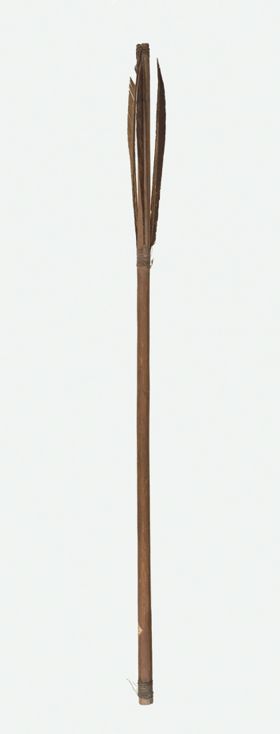Shaft of an arrow
Place: Alaska
Category: Fishing & hunting
wood, feathers, plant fibre, animal skin, Unalaska, northern Pacific, l. 54 cm, Inv. Am 1100
Alaska - Probably Chugach or Koniag, Cook Inlet,, Inv. Am 1100
Humphrey No. 326: ‘a short arrow made of fir; feathered, and pointed with bone having 2 barbs and also an additional point made of a blue slate ground very sharp. From ditto [Unalaschka]. NB. To preserve the slate points the Natives make Sheaths for them of Deer’s skin.’
The wooden shaft is round in cross-section at the front, whereas the notched rear end is flattened. The radial feathering of three half-feathers is lashed to the shaft at the front end with a cord of plant fibre, and at the rear end with two-ply (S-twisted) sinew threads. The front end of the shaft, which is deeply hollowed out, is wrapped with a similar sinew thread to prevent splintering.
Humphrey’s list reveals that the shaft originally had a ‘foreshaft’ made of bone with two barbs, and that the actual point was made out of a sharpened piece of slate. Unfortunately, these two components are missing, as is the leather sheath for the stone point mentioned by Humphrey (assuming Humphrey’s comment in this respect was intended not only as additional information). A similar arrow with foreshaft and point, in addition to three more without points, are held in the Berne Collection. However, the original list mentioned ‘1 bow and arrow from Prince William’s Sound’, with a total of seven arrows and six harpoon arrows, as well as a bow (Henking 1957: 371-73, Fig. 39c, f, e; Kaeppler 1978b: 24, 67-69, Fig. 127). Details of other possible comparable pieces from other Cook collections (two in Cape Town, thirteen in Sydney) have not been published (Kaeppler 1978a: 274). A slate point attributed to Cook in the British Museum has an old label ‘Nootka Sound’, but is probably from a northern part of the coast (King 1981: 56, PI. 37). Archaeological evidence for such points exists from the region of the Chugach (de Laguna 1934: 24, 70f, PI. 31, Fig. 14) and Koniag (Clark 1974: PI. 16, 17). The very similar Koniag arrows of the Etholén Collection in Helsinki have a barbed ‘foreshaft’ with a slate point; two wooden arrow sheaths have also been preserved. These arrows were used for bear hunting, and by around 1850 were no longer being made (Varjola 1990: 300, No. 512).
Both Humphrey’s ‘Unalaschka’ as a provenance for the arrow, as well as Webber’s ‘Prince William Sound’ for those which he collected, are unlikely. All the evidence suggests that the arrows were acquired in Cook Inlet. Christian F. Feest
Sources
Clark, Donald Woodforde, Koniag Prehistory. Archaeological Investigations at Late Prehistoric Sites on Kodiak Island, Alaska, Tübinger Monographien zun Urgeschichte, 1, Stuttgart, 1974.
de Laguna, Frederica, The Archaeology of Cook Inlet. Alaska, Philadelphia, 1934.
Henking, Karl H, ‘Die Südsee- und Alaskasammlung Johann Wäber. Beschreibender Katalog’, in Jahrbuch der Bernischen Historischen Museums in Bern, 1957, vols 35-36, pp. 325-389.
Kaeppler, Adrienne L, ‘Artificial Curiosities’ Being An Exposition of Native Manufactures Collected on the Three Pacific Voyages of Captain James Cook RN [Exhibition catalogue], Bishop Museum Press, Honolulu, 1978a.
Kaeppler, Adrienne L, Cook Voyage Artifacts in Leningrad, Berne and Florence Museums, Bishop Museum Press, Honolulu, 1978b.
King, JCH, Artificial Curiosities from the Northwest Coast of North America, London, 1981.
Varjola, Pirjo, The Etholén Collection. The Ethnographic Alaskan Collection of Adolf Etholén and his Contemporaries in the National Museum of Finland, Helsinki, 1990.

